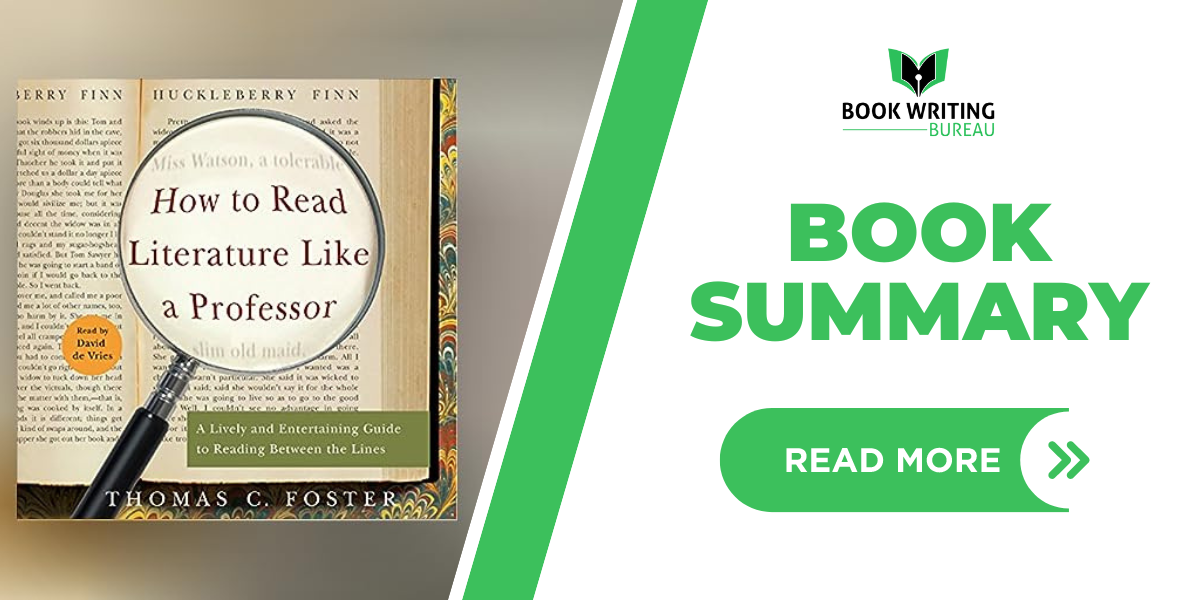
Book
Unsurprisingly, Thomas C. Foster is an English professor. He offers examples from outstanding works to show how to open a book and discover what’s happening underneath the surface.
This book will not only make reading more engaging and entertaining, but it can also help you in putting what you learn into practice in a much more professional manner.
Plot Summary of How to Read Literature Like a Professor
Foster says at the beginning of the book that it was written for adults and non-traditional college students new to literature analysis. So, it was a big surprise that the book became so popular in high schools and was even added to the list of books taught in AP Literature classes.
Foster explains how teachers read by saying that most students don’t want to read in a “professional” way. It might look like the professor is just pulling analysis out of thin air, but in reality, they have just learned the “language of reading,” a set of tools and rules that help experts to connect with literature on a deeper and more complex level.
Memory, symbols, and patterns are the most important parts of understanding language.
Understand Memory, Symbols, and Patterns:
Here are three tips to help you hire book illustrators and learn how to read well:
- The greater meaning of any book is hidden in memory, symbols, and patterns.
- The quest format is one of the most popular themes.
- Look for messages belonging to everyone in books to determine the authors’ symbols.
Most people are what you might call “shallow readers.” When reading books, they pay little attention to anything beyond the basic story. Foster says you need to watch out for three things if you want to go beyond that and understand what you’re reading.

Memory:
It has happened to you. You’ve read a book chapter and thought, “Wait, haven’t I heard this story before?” Have I already read about this?” Smart readers pay attention to that feeling. Instead, they think about what they just read and compare it with a similar book they’ve read before.
Symbols:
Harry Potter’s scar on his forehead is more than just a scar. Its shape, how it hurts, and the dreams it gives him. It’s more than just a mistake; it’s a sign, and you’ll only understand the whole story if you can figure out what it means.
Patterns:
Every once in a while, the same small, seemingly unimportant details keep coming up. The story follows a pattern, as do some characters, things, and even words. Authors often use patterns to send secret messages.
Importance of Literature:
Literature can change people’s lives by letting them dive into fascinating worlds, connect with people, and learn about deep ideas. But the depth of literary works often hides a lot of secret meanings, cultural references, and symbols. Thomas C. Foster’s book, “How to Read Literature Like a Professor,” is a must-read for anyone who wants to discover what books are hiding. The most important ideas from Foster’s book can help you enjoy reading and learn more about it.
How to Read Literature Like a Professor Themes?
How to Read Literature Like a Professor is Explained through Its Theme, Which Includes a Detailed Description, Analyzed Timeline, and Visual
Metaphor and Symbol:
Among the many literary strategies the book explores, symbolism and metaphor are two of the most essential. There is a significant difference between them despite their similarities in meaning.
Symbols are elements of literature that carry additional meanings beyond their primary or simplest interpretations. In contrast, a metaphor is a figure of speech that does not use literal language to convey a concept.
Surface vs. Deeper Reading:
Foster explains that he authored How to Read Literature Like a Professor to solve a specific issue: laypeople tend to skim rather than delve deeply into literature. Similar to how one “reads” real-world circumstances, such as accepting individuals at face value when they talk or deciding there is no symbolic meaning to someone’s illness, this reading approach assumes no hidden meaning in the text.
Intertextuality:
“intertextuality” describes the relationship between all writings (particularly literary works) written at any time. Foster pushes readers throughout the book to consider the cultural and religious contexts (Greek myth, the Bible), genres (vampire stories, fairy tales), and authors (Shakespeare, the Brothers Grimm) to which literary pieces belong.
Recognizing Patterns:
In literature, archetypes are characters ingrained in readers’ minds via imitation, modification, and subversion; they are figures that have repeatedly appeared in myth and other cultural tales.
For instance, the characteristics that came to define the hero archetype in ancient mythology are strength, bravery, and physical attractiveness. These days, a literary hero can have some of these traits but not others and yet be easily distinguishable from other heroes.
Culture, History, and Literature:
The primary goal of this book is not to help high school pupils pass their English classes or to introduce college students to the realm of literary study. Instead, there’s value in “reading literature like a professor” even outside of academia.
Characteristics and Literary Elements:
There are many of these characteristics or literary elements, and Foster doesn’t try to cover them all in his book. Instead, he focuses on the ones he thinks are most important.
So, the book points out traditions and older texts, like Shakespeare, the Bible, Greek mythology, and fairy tales, from which literature borrows greatly and makes references. How to Read also looks at the text’s setting, weather, organizational structure (Sonnet), and themes like blindness, food, supernatural animals, flight, irony, and outside influences.
So, the book looks at a wide range of conventions, from outside historical texts to worries about themes to text-specific features.
Main Concepts of How to Read Literature Like A Professor:
“How to Read Literature Like a Professor” by Thomas C. Foster is a well-known book. It is a guide to understanding and analyzing literature. It was made for students and others wanting to learn more about books. The goal of the book printing services is to make it easier to understand how to read and understand literature by showing how different literary methods, symbols, themes, and patterns are used.
Here is a brief overview of the most important ideas in the book:
Interpreting Literature:
This book talks about how important it is to understand that writing is more than just a story; it’s a way to share deeper ideas and meanings. It makes them think more about what they’re reading.
The Quest:
The main character in many stories quests to reach a certain goal. These quests can involve the body, the mind, or the spirit. Also, they often involve hurdles and problems that help people grow.
Symbols and Themes:
Foster talks about the importance of using symbols and themes in writing. In the same way, recurring symbols and subjects help readers understand what the author is trying to say. And what the most important point is.
References to the Bible and Mythology:
A lot of writing uses the Bible and mythology to help explain what they mean. Seeing how these things fit together can help you figure out the story.
Other concepts of How to Read Literature Like A professor:
- Fairy Tales and Archetypes is a book about how fairy tales and typical characters are used in writing. These factors have always been important to people, no matter where or when they live.
- Shakespeare and Classic Literature: Foster talks about how Shakespeare and other classic works have influenced modern works for a long time. Knowing how these classics are in modern writing can help you understand them better.
- Irony and ambiguity: Irony and ambiguity are extensively used in the literature to explain ideas. The text becomes more meaningful when you understand how these literary methods work.
- Geography and Setting: Foster says knowing where and how a story takes place is important. Setting can have a big effect on people and plots.
- Commentary on politics and society: Literature often shows how politics and society were at the time. By looking at these parts, you can determine what the author thinks about today’s world.
- Memory and Dream: This book examines how literature often blurs the lines between truth and memory, dream, or imagination. This weaving together gives the story more meaning.
Conclusion:
How to Read Literature Like a Professor” by Thomas C. Foster is a helpful guide that gives readers the tools they need to learn more about literature. However, Foster’s insightful analysis highlights the secret symbols, recurring themes, and deeper meanings in literary works, making them easier to understand and appreciate.
The book invites us to tell stories by giving us the tools we need to understand the complexities of literature. Therefore, the literature reflects the human experience. Also, a way to explore the depths of our imagination and understanding. With this new information, we’ll be better able to travel the complex landscapes of the written word and find hidden meanings.



